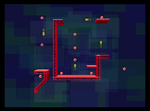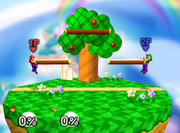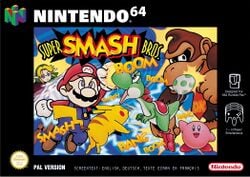Super Smash Bros.: Difference between revisions
Tag: Mobile edit |
m (Undid edit by 136.36.44.168: Can't be newcomers if this is the first, nor does the wording make sense) Tag: Undo |
||
| Line 35: | Line 35: | ||
[[File:SSBCast.jpg|thumb|194x205px|Official artwork of the default cast of ''Smash 64''.]] | [[File:SSBCast.jpg|thumb|194x205px|Official artwork of the default cast of ''Smash 64''.]] | ||
[[File:Super Smash Select.png|thumb|The character-selection screen of ''Super Smash Bros.'' (all characters unlocked).]] | [[File:Super Smash Select.png|thumb|The character-selection screen of ''Super Smash Bros.'' (all characters unlocked).]] | ||
There are twelve | There are twelve [[Fighter|playable characters]] in ''Super Smash Bros.'', eight of which are available from the [[Starter character|start]] and four of which are [[Unlockable character|unlockable]]. | ||
The highest amount of character slots are given to the {{uv|Super Mario}} and {{uv|Pokémon}} universes with each receiving two fighters: [[Mario]] alongside his brother [[Luigi]], and [[Pikachu]] and [[Jigglypuff]] respectively, with the latter characters in both universes being unlockable. | The highest amount of character slots are given to the {{uv|Super Mario}} and {{uv|Pokémon}} universes with each receiving two fighters: [[Mario]] alongside his brother [[Luigi]], and [[Pikachu]] and [[Jigglypuff]] respectively, with the latter characters in both universes being unlockable. | ||
Revision as of 15:31, April 14, 2024
| “ | Something's gone wrong in the happy-go-lucky world of Nintendo! | ” |
| —North American commercial | ||
| Super Smash Bros. | |
|---|---|
| Developer(s) | HAL Laboratory, Inc. |
| Publisher(s) | Nintendo |
| Designer(s) | Masahiro Sakurai |
| Released | Nintendo 64: iQue Player: Virtual Console: |
| Genre(s) | Fighting game Platforming |
| Mode(s) | Single-player, multiplayer (2-4) |
| Ratings | ESRB: E PEGI: 7 OFLC: G8+ |
| Platform(s) | Nintendo 64 iQue Player Virtual Console |
| Media | 128 megabit cartridge 256 megabit cartridge (Europe) Flash Card (China) |
Super Smash Bros. (ニンテンドウオールスター! 大乱闘スマッシュブラザーズ, Nintendo All-Star! Great Fray Smash Brothers), also called Super Smash Bros. 64, often shortened to SSB or Smash 64, is the first game of the Super Smash Bros. series.
The game released in Japan on January 21st, 1999, in North America on April 26th, 1999 and in Europe on November 19th, 1999 for the Nintendo 64. Subsequently, it released on the iQue Player in China on November 15th, 2005. It was re-released on the Wii Virtual Console on January 20th, 2009 in Japan, a day before its 10-year anniversary, and later that year in Europe and North America, before becoming unavailable after the Wii Shop Channel shut down on January 30th, 2019.
Super Smash Bros. received positive reviews, with most praise going to its multiplayer mode, while its single-player mode received some criticism. The game has sold 5 million units worldwide as of 2001, making it the fifth best-selling Nintendo 64 game of all time.
Opening movie
The opening movie in Super Smash Bros., unlike later games in the Super Smash Bros. series, completely lacks pre-rendered footage. It instead opts to use the game engine to render everything in real-time.
When the opening movie starts, two random starter characters are placed by Master Hand on top of a desk, which shortly transitions to a scene resembling Peach's Castle. This process is repeated every time the opening movie is played.
As the opening movie concludes, the figures of the four unlockable characters are flashed against a white background. If a character hasn't been unlocked, they will simply be shown as a silhouette; conversely, they will be revealed once unlocked.
Finally, the opening movie segues into the title screen, a trend which would be followed by future installments, along with the announcer calling out the game's title.
Fighters
There are twelve playable characters in Super Smash Bros., eight of which are available from the start and four of which are unlockable.
The highest amount of character slots are given to the Super Mario and Pokémon universes with each receiving two fighters: Mario alongside his brother Luigi, and Pikachu and Jigglypuff respectively, with the latter characters in both universes being unlockable.
Two more slots are given to reoccurring Mario characters Donkey Kong and Yoshi as starting fighters from their sub-universes of the same names, Donkey Kong and Yoshi.
The other starter characters are Link, Samus, Kirby and Fox from The Legend of Zelda, Metroid, Kirby and Star Fox universes, respectively. The final remaining characters, as with Luigi and Jigglypuff, are unlockable: Ness of EarthBound and Captain Falcon of F-Zero.
| Starters (8) | |||
|---|---|---|---|
 Mario |
 Yoshi |
 Donkey Kong |
 Link |
 Samus |
 Kirby |
 Fox |
 Pikachu |
| Unlockables (4) | |||
 Luigi |
 Jigglypuff |
 Captain Falcon |
 Ness |
Stages
The game features nine stages derived from each character's universe, exceptions being EarthBound and F-Zero. While most universes receive a single stage, Mario uniquely has two instead: Peach's Castle and the only unlockable stage in the game, Mushroom Kingdom. The other stages consist of Congo Jungle, Hyrule Castle, Planet Zebes, Yoshi's Island, Dream Land, Sector Z, and Saffron City from Donkey Kong, The Legend of Zelda, Metroid, Yoshi, Kirby, Star Fox, and Pokémon respectively.
Versus mode stages
| Versus mode (9) | ||||
|---|---|---|---|---|
 Peach's Castle |
 Mushroom Kingdom |
 Yoshi's Island |
 Congo Jungle |
 Hyrule Castle |
 Planet Zebes |
 Dream Land |
 Sector Z |
 Saffron City |
|
Shown in bold, Mushroom Kingdom is the only unlockable stage in Super Smash Bros.
1P Game-only stages
| 1P Game-only | ||||||
|---|---|---|---|---|---|---|
 Break the Targets |
 Board the Platforms |
 Race to the Finish |
 Yoshi's Island* |
 Meta Crystal |
 Duel Zone |
 Final Destination |
These stages only appear in the 1P Game.
*The 1P Game-only Yoshi's Island lacks clouds and has closer blast zones.
Non-playable stages
| Non-playable | ||
|---|---|---|
 Small |
 New |
 Tutorial Stage |
These stages cannot normally be unlocked or played on in any way without hacking.
Modes
1-Player
Multiplayer
Development
After development on Kirby Super Star wrapped in 1996, creator Masahiro Sakurai wanted to create another property. He developed two different prototypes concurrently: a stealth and exploration based RC robot adventure game, and a four player free-for-all fighting game with no health bars. A long-time fan of fighting games, particularly games developed by SNK, he was interested in making a beginner friendly fighting game for four players. A specific inspiration for such an idea came from an experience at a local arcade where he had a winning streak on King of Fighters '95 and felt pleased with himself, only to feel guilty upon realizing his opponent was a beginner and their partner. This inspired Sakurai to design a game that would be fun regardless of skill level.[1] He also was concerned about combos pervading the fighting game genre and felt they invalidated the skills of those subjected to them. Command-input moves were also becoming increasingly complex, and Sakurai wanted controls that tested speed and reflexes instead of muscle memory, which culminated in tilt attacks and smash attacks that can be performable with a wide range of skill levels while still having a level of depth and strategy.[2]
His initial design for the game was called Kakuto-Geemu Ryuoh (Dragon King: The Fighting Game),[3] which featured simple characters. After presenting the game to co-worker Satoru Iwata, he helped Sakurai continue on with the project. Realizing that the RC game would take much longer to develop, he shelved the concept and went all in on this fighting game. Understanding that many fighting games did not sell well, Sakurai strove to make his game original.[3] After presenting a pre-alpha demo to HAL Laboratory, he was approached by a fellow employee who suggested the game should include famous Nintendo characters as a way to market the game.[3] Initially hesitant about the idea, he was later convinced and began retooling his demo. Sakurai has since claimed that filling a game with preexisting characters is more welcoming to new players instead of bombarding them with many original characters they are unfamiliar with. Knowing full well that he would not receive permission to include their characters, Sakurai created a prototype of the game without sanction from Nintendo and did not inform them until he was sure the game was well-balanced.[3] The prototype he presented featured Mario, Donkey Kong, Samus Aran, and Fox McCloud as playable characters. The idea was later approved.[3][4] Although never acknowledged by Sakurai or any developers behind Super Smash Bros., third party sources have identified Namco's 1995 fighting game The Outfoxies as a possible inspiration.[5][6]
HAL Laboratory was assigned as primary developers, as Sakurai was employed by them at the time. While Sakurai and Iwata were initially the only developers, as other projects in HAL Laboratory either were finished or fell through, more employees were brought on the project to assist them. Multiple characters, including Marth, King Dedede, Bowser, and Mewtwo were planned to be playable at one point, but were all cut for various reasons.
Super Smash Bros. features music from Nintendo's most popular gaming franchises. While many tracks are new arrangements for the game, some songs attempt to directly emulate their sources. The music for Super Smash Bros. was composed by Hirokazu Ando, who later returned as sound and music director for Super Smash Bros. Melee. A complete soundtrack was released on CD in Japan through Teichiku Records in 2001.[7]
Marketing teams and wholesalers were initially skeptical on the market viability of Super Smash Bros., as they were unsure how the public would respond to Nintendo characters fighting each other. Resistance from fighting game players were also met during the launch period, as they had many preconceptions of what a fighting game is and were uncomfortable with a wildly different product labeling itself as a fighting game. To alleviate this tension, Sakurai created the Sumabura-Ken website that delved into the game's different concepts.
To promote the game's launch, Nintendo of America staged an event called Super Smash Bros. Slamfest '99, held at the MGM Grand Adventures Theme Park in Las Vegas, Nevada, on April 24th, 1999. The event featured a real-life wrestling match between costumed performers dressed as Mario, Yoshi, Pikachu, and Donkey Kong, as well as stations set up for attendees to preview the game. The wrestling match was live-streamed on the web via RealPlayer, and was available to be re-watched for several months afterward via a downloadable file from the event's official website. Despite this, no video footage of Slamfest '99 is known to survive, and the broadcast is currently considered lost media.
Reception
| SSB reviews | |
|---|---|
| Publication | Score |
| Famitsu | 31 of 40[8] |
| GameSpot | 7.5 of 10[9] |
| IGN | 8.5 of 10[10] |
| Nintendo Power | 7.7 of 10[11] |
| Compilations of multiple reviews | |
| Metacritic | 79 of 100[12] |
| Game Rankings | 78.81%[11] |
| Awards | |
| IGN "Best Fighting Game" | |
Super Smash Bros. was a commercial success, selling 5 million copies worldwide with 2.93 million sold in the United States and 1.97 million copies sold in Japan. It was the 5th best selling game for the Nintendo 64. Reviews were mostly positive, with many critics praising the game's addictive and fun multiplayer gameplay and simple controls, but it was criticized as well, mainly due to the game's lower amount of content and somewhat limited single-player mode.
In competitive play
Smash 64 has always had a small, niche competitive scene relative to future entries. Unlike those entries, particularly Brawl and Smash 4, the scene has increased in popularity over the years instead of falling off when the next entry releases. This is mostly due to the scene embracing emulation and other unconventional methods of play quicker than the others, which allowed them to smoothly transition to online play, especially during the 2020 pandemic. While dedicated tournaments are still sparse, Smash 64 is more frequently becoming held as an event in major tournaments alongside future entries with gradually increasing entrant counts. The scene was also the first and currently most popular to run the Combo Contest due to the game engine allowing for great amounts of freedom in that department. The scene is also kept alive with mods such as Smash Remix, which expands on the game's content while keeping core elements intact.
The community has constructed a set of standard tournament rules to regulate tournament play. While rulesets may vary between different tournaments, generally universal gameplay rules include all matches being played via timed stock (four stocks and eight minutes), and restrictions on legal stages. These regulations are enacted to ensure that gameplay at the highest level remains fair and interesting.
Gallery
Staff
Trivia
- This is the only Super Smash Bros. game to:
- Release in the 1990s.
- Be rated "E" for Everyone by the ESRB.
- Lack Home-Run Contest and Multi-Man Smash modes.
- Use the phrases "Game Set" and "Time Up" for matches in all regions.
- Lack a stage from the F-Zero and EarthBound universes.
- Not have Battlefield and Final Destination as Versus Mode stages.
- Not feature spot dodges, air dodges, charged smash attacks, side special moves, pummels, up throws or down throws, as these would be added in later games.
- Have multiple crowd reactions for when a character recovers.
- Not introduce at least one Fire Emblem character.
- Not show any magnifying of computer players when playing against a team in 1P mode, although the camera may ignore the said computer player's presence.
- The starting eight characters are placed in the order of when they first appeared (as a whole) in their respective debut titles on the character selection screen, starting with the oldest, Mario and Donkey Kong, and ending with the most recent, Pikachu. This same order is used when listing the cast of the original Super Smash Bros. in later games, such as when organizing trophies and fighter numbers. This chronological ordering also applies to the four unlockable characters on the character selection screen, though this is only relative to each other and not the other characters.
- Super Smash Bros. marks the first appearance of Samus, Kirby, and Ness in 3D.
- Additionally, this game is both Samus and Ness's only appearance on the Nintendo 64.
- This game has the fewest amount of unlockable characters with four.
- This game is one of two that uses 2D illustrations on the box art, alongside Super Smash Bros. Ultimate.
- This game is one of two Super Smash Bros. games to not feature Adventure Mode, the second being Super Smash Bros. 4.
- This game is one of two Super Smash Bros. games to not feature All-Star Mode, the second being Super Smash Bros. Ultimate.
- If the player achieves No Miss x11 at the end of Classic Mode with a score over “01000000”, the announcer will say "Incredible!" instead of "Congratulations!" on the victory screen.
- Counting both versions of Super Smash Bros. 4 as one game, this is the only game in the series with more fighters than stages.
- Despite Super Smash Bros. having its own Australian version, the European version was used for Australia's Virtual Console.
- Although the iQue player has a built-in controller, a message, albeit in Chinese, exists dictating that the controller is not plugged in.[13]
External links
- Official Japanese Super Smash Bros. website
- Official English Super Smash Bros. website (archived)
- Official Japanese Virtual Console Super Smash Bros. website
- Official European Super Smash Bros. game page
- Official North American Virtual Console Super Smash Bros. game page
- Official Chinese Super Smash Bros. website
References
- ^ MacDonald, Keza (August 8, 2018). From Kong to Kirby: Smash Bros' Masahiro Sakurai on mashing up 35 years of gaming history. The Guardian.
- ^ Super Smash Bros.. YouTube (2022-10-20). Retrieved on 2022-10-20.
- ^ a b c d e Iwata Asks: Super Smash Bros. Brawl. Nintendo. Retrieved on 2008-01-31.
- ^ 社長が訊く『大乱闘スマッシュブラザーズX』 (Japanese). Nintendo. Retrieved on 2008-01-31.
- ^ Holmes, Jonathan. "Six Days to Smash Bros. Brawl: Top Five Smash Bros alternatives", Destructoid, March 3, 2008.
- ^ Sullivan, Lucas (September 19, 2014). 15 Smash Bros. rip-offs that couldn't outdo Nintendo.
- ^ Nintendo All-Star! Dairanto Smash Brothers Original Soundtrack. Soundtrack Central (2002-01-17). Retrieved on 2008-04-16.
- ^ ニンテンドウ64 - ニンテンドウオールスター!大乱闘スマッシュブラザーズ. Weekly Famitsu. No.915 Pt.2. Pg.32. 30 June 2006.
- ^ Gerstmann, Jeff (1999-02-18). Super Smash Bros. Review. GameSpot. Retrieved on 2008-04-26.
- ^ Schneider, Peer (1999-04-27). Super Smash Bros. Review. IGN. Retrieved on 2008-04-26.
- ^ a b Super Smash Bros. Reviews. GameRankings. Retrieved on 2013-07-14.
- ^ Super Smash Bros. (n64: 1999): Reviews. Metacritic. Retrieved on 2013-07-14.
- ^ No Controller.
| Super Smash Bros. series | |
|---|---|
| Super Smash Bros. · Super Smash Bros. Melee · Super Smash Bros. Brawl · Super Smash Bros. 4 (for Nintendo 3DS · for Wii U) · Super Smash Bros. Ultimate |
















